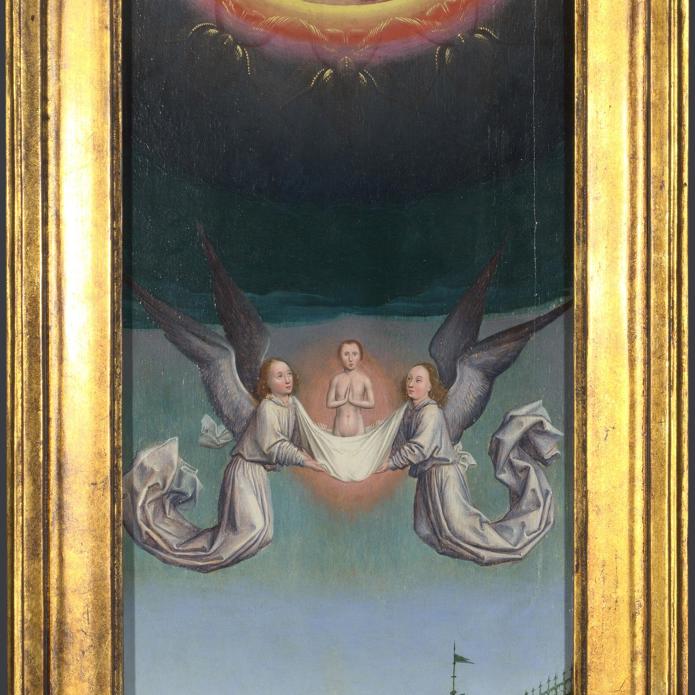Simon Marmion, 'A Choir of Angels: From Left Hand Shutter', about 1459
About the work
Overview
These musical angels were originally at the top of the left wing of an elborate altarpiece that sat at the high altar of the Abbey of St Bertin in Saint-Omer, northern France. Beneath them Guillaume Fillastre, abbot of St Bertin and the altarpiece’s commissioner, knelt at prayer inside a Gothic building – you can see its top at the bottom of this panel..
The angels play instruments that look like shawms, a Renaissance forerunner of the oboe. The symbols on the scroll held by the two lower angels are not real musical notation and were never readable. On the back, a Gothic stone canopy is painted in grisaille (shades of black, white and grey).
When the wings of the altarpiece were closed, this panel and its twin, The Soul of Saint Bertin carried up to God, would have covered the gilded silver Crucifixion in the centre of the altarpiece.
Key facts
Details
- Full title
- A Choir of Angels: From Left Hand Shutter
- Artist
- Simon Marmion
- Artist dates
- active 1449; died 1489
- Part of the series
- Fragments of Shutters from the St Bertin Altarpiece
- Date made
- about 1459
- Medium and support
- oil on wood
- Dimensions
- 57.6 × 20.9 cm
- Acquisition credit
- Bought, 1860
- Inventory number
- NG1303
- Location
- Not on display
- Collection
- Main Collection
- Frame
- 20th-century Replica Frame
Provenance
Additional information
Text extracted from the ‘Provenance’ section of the catalogue entry in Lorne Campbell, ‘National Gallery Catalogues: The Fifteenth Century Netherlandish Schools’, London 1998; for further information, see the full catalogue entry.
Exhibition history
-
2017Monochrome: Painting in Black and White.Museum Kunstpalast22 March 2018 - 15 July 2018
-
2022Between Hell and Paradise: The Curious World of Hieronymus BoschSzépművészeti Múzeum7 April 2022 - 17 July 2022
Bibliography
-
1945Davies, Martin, National Gallery Catalogues: Early Netherlandish School, London 1945
-
1955Davies, Martin, National Gallery Catalogues: Early Netherlandish School, 2nd edn (revised), London 1955
-
1987Davies, Martin, National Gallery Catalogues: The Early Netherlandish School, 3rd edn, London 1987
-
1998Campbell, Lorne, National Gallery Catalogues: The Fifteenth Century Netherlandish Paintings, London 1998
-
2001
C. Baker and T. Henry, The National Gallery: Complete Illustrated Catalogue, London 2001
Frame
This frame was made in 1991 at the Gallery. Made from pinewood and water-gilt, it has step mouldings and an ogee leading to the sight edge.
Inspired by early Italian styles, this double-sided frame was made for the opening of the new Sainsbury Wing.
About this record
If you know more about this painting or have spotted an error, please contact us. Please note that exhibition histories are listed from 2009 onwards. Bibliographies may not be complete; more comprehensive information is available in the National Gallery Library.
Images
About the series: Fragments of Shutters from the St Bertin Altarpiece

Overview
These two paintings – The Soul of Saint Bertin carried up to God and A Choir of Angels – were once the upper parts of the wings of an elaborate altarpiece that was made for the high altar of the abbey church of St Bertin at Saint-Omer in northern France. It was commissioned by Guillaume Fillastre, Abbot of St Bertin, and was consecrated in 1459.
The wings are thought to have been painted at Valenciennes, where Simon Marmion was almost certainly the leading painter; he had moved there from Amiens between 1454 and 1458. The main parts of the wings are now in the Gemäldegalerie, Berlin. On the inside these show Fillastre himself with scenes from the life of Saint Bertin. The central section is known only from written descriptions, but was in the shape of an inverted ‘T’ and was made of gold, gilded silver and copper, rock crystal, diamonds and other precious stones.



